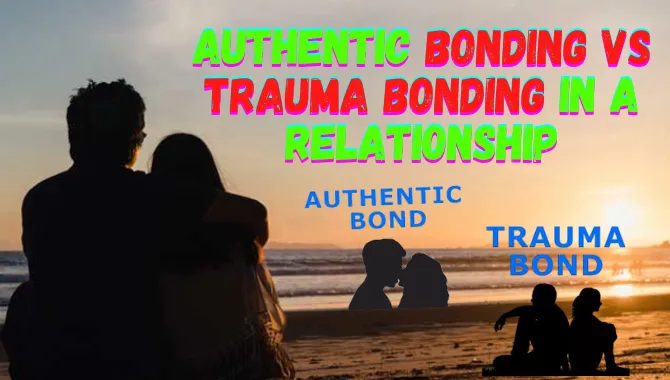In the world of relationships, there are two types of bonding that often occur – authentic bonding and trauma bonding. While both forms of bonding have their benefits and drawbacks, it’s important to understand their differences before attaching to either type of relationship.
As we’ll see in this blog, authentic bonding is characterized by an emotional connection based on mutual understanding and shared experience. This type of bond is stable and can withstand stress and strain.
Trauma bonding, on the other hand, is typically based on fear or violence and is unstable. It often leads to feelings of isolation and detachment from the relationship. Knowing the characteristics of each type of bonding can help you make the best decision for your relationship.
But don’t worry – dealing with a trauma-bonding relationship isn’t impossible. Please read our article on authentic bonding vs. trauma bonding in a relationship. And know Effective tips on how to cope with a relationship that falls into this category.

What Is Authentic Bonding In A Relationship?
Authentic bonding is where both partners feel comfortable and safe sharing their emotions. This bond is vital in healthy relationships because it allows for trust and communication to develop freely. Authentic bonding is based on mutual understanding and shared experience, which makes it strong and reliable. Some of the benefits of authentic bonding include the following:
- It allows for healthy communication between partners.
- It creates a sense of closeness and intimacy.
- It facilitates positive relationship dynamics, such as sharing responsibilities and lending support.
- It can help build resilience in the face of stress or challenge.
What Is Trauma Bonding In A Relationship?
Trauma bonding occurs when one partner feels scared or threatened by the other. This type of bond is typically based on violence or fear and can be very unstable. It often leads to feelings of isolation and detachment from the relationship. The following are some of the signs that a relationship may be trauma-bonding:
- One partner tends to avoid emotional intimacy.
- There is frequent conflict and disharmony between partners.
- Both parties tend to rely on physical abuse as a way of coping with stress or
Characteristics Difference Authentic Bonding Vs. Trauma Bonding In A Relationship.

There’s a big difference between authentic bonding and trauma bonding in a relationship. Authentic bonding is a healthy and positive relationship in which both parties feel safe and comfortable being themselves.
On the other hand, trauma bonding is often a negative relationship in which one person feels controlled or threatened by the other. Trauma bonds are often formed during stress or trauma.
for example, when a child is separated from their parents during wartime. The effects of trauma bonding can be devastating to both parties involved in the bond, leading to problems such as trust issues and communication difficulties.
If you’re wondering why your relationship is struggling, it’s worth taking a closer look at the characteristics of these two types of bonding. If you’re in a trauma-bonding relationship, it’s important to seek help. Many resources are available to help you break free from the toxic bond and regain the healthy relationship you once had.
Authentic Bonding Characteristics
In a relationship, it’s important to find a type of bonding that suits both parties. While trauma bonding is characterized by a lack of empathy and mutual respect, authentic bonding is characterized by empathy, mutual respect, and a sense of shared ownership.
This type of bond can lead to feelings of control, vulnerability in the other person, and isolation. It’s important to be aware of the signs that you’re bonding in a healthy way instead of in a toxic way to avoid forming a toxic relationship.
These signs include feeling connected, having positive communication, and feeling like the relationship is something that you’re willing to invest in. If you notice any of these signs, it’s best to seek help from a relationship expert or therapist who can help you navigate the tricky waters of love.
Love Is Unconditional
Authentic love is unconditional and doesn’t depend on anything in return. It’s a type of love that gives you a feeling of security and peace, knowing that the other person will always be there for you no matter what.
On the other hand, trauma bonding is based on fear or anxiety, which often leads to betrayal or hurt feelings. When two people are in an authentic relationship free from expectations – whether those expectations are romantic or not – they can find solace and healing after trauma bonding ends.
Inauthentic relationships don’t offer this same level of safety and security as true love because they’re built upon something else: damaged trust, manipulation, power games, etc.
Never Having To Be Bound To Expectations
Understanding the difference between trauma and authentic bonding is of utmost importance if you want a healthy relationship. Trauma bonding is based on fear and control.
As a result, it leads to problems like trust issues, communication breakdowns, etcetera. In contrast, authentic bonding is founded on mutual respect and sharing of vulnerabilities.
This type of bond allows for true understanding and connection, which leads to positive outcomes like increased intimacy, security, trustworthiness, etcetera. So make sure you don’t confuse trauma with love – they are two very different things!
Love Means Letting Go Gracefully
Love is a powerful thing. It can create positive emotions, strengthen relationships, and help us grow as individuals. However, love also comes with vulnerabilities, making it risky to open up fully and be true to ourselves.
Authentic bonding allows for more comfortable sharing of emotions which in turn helps the relationship grow stronger over time. On the other hand, trauma bonding is based on fear; when we are afraid or experiencing trauma, we may cling to people or patterns of relating to surviving.
This kind of attachment doesn’t allow for healthy emotional growth since it only protects us from further pain instead of strengthening our relationship ties.
Love Is Synonymous With Empathy

When you are in love, it is natural to feel empathy for the person you are with. This feeling of connection leads to feelings of warmth and security, making it difficult to break free from trauma bonding.
However, if you want to get out of an abusive relationship or one based on trauma bonding, finding a new love with authentic bonding characteristics will be beneficial. Such a partner won’t put your safety at risk and will help heal the emotional wounds caused by your previous relationship.
Love Means Being A Part Of A Team

Love is a wonderful bonding experience that can make us feel incredibly connected to another person. It happens when two people work together harmoniously towards a common goal, experiencing mutual respect and understanding.
On the other hand, trauma bonding is based on fear and violence – something that rarely leads to positive outcomes. While love may not always be easy or perfect, it’s worth striving for because it brings us closer to who we are.
Love Makes You Feel Content, Not Anxious
Love is the key to happiness and contentment. That’s why two people must develop healthy relationships based on love and care. Authentic bonding occurs when two people are deeply connected based on love and care.
This form of bonding leads to feelings of contentment since it allows both partners to feel safe and secure. In contrast, trauma bonding happens when one partner feels a lot of anxiety in their relationship – leading them to experience negative emotions such as stress, sadness, or fear.
The key thing you can do to avoid getting traumatically bonded is to develop a strong connection with your partner founded on love and caring instead of anxiety-producing situations. Doing so will allow you to build an emotional safety net that will help protect you from any negative experiences in your romantic relationships.
Characteristics Of A Trauma Bond Relationship

When two people are trauma bonded, they are deeply connected and share intense emotional experiences. This relationship is often formed after a traumatic event, such as a natural disaster or personal injury. Trauma bonding is also strong when one person becomes a caretaker to the other during this time of need.
Characteristics of a trauma bond relationship include reliance on each other, high levels of communication, and an inability to emotionally separate from one another.
This type of relationship can be beneficial in some ways but can also be toxic and damaging in the long run. If you’re looking for a more authentic and healthy relationship, trauma bonding might not be the best option for you.
The Cycle Of Abuse
There is a cycle of abuse in relationships – abusers use violence and intimidation to control their partner. This cycle often results in trauma bonding, in which the victim develops emotional attachments to the abuser. This can make it difficult for them to get away or report abuse because they feel responsible for it.
Authentic bonding aims to break the cycle of abuse and rebuild trust in the relationship. This process requires patience, understanding, and a lot of hard work. However, it is worth it, because the relationship can be saved and rebuilt.
Stage 1: Tension
When a relationship starts off, there may be some tension as the two parties try to figure each other out. This can lead to anger and resentment, creating a cycle of abuse. The key is for both partners to break this cycle by identifying the signs of abuse and getting help.
Trauma bonding occurs when one partner becomes so invested in the relationship that they lose sight of their own needs. As such, it becomes difficult for them to let go even if it’s best for both of them.
This often leads to severe trauma, eventually leading to divorce or separation. If you feel unsure about your relationship or notice any red flags indicating an abusive situation, you must get help from a professional before things get worse!
Stage 2: Incident
In stage two of the abuse cycle, the abuser begins to groom and manipulate the victim. This might involve making them feel special, buying them gifts, or cuddling them in order to make them feel loved.
The goal is to build a trusting relationship where the victim believes they can trust the abuser and ask for what they want. At this point, abuse has become normalized and often goes unnoticed or unreported due to fear of reprisal from the abuser.
Stage 3: Reconciliation
Reconciliation is a key stage in the cycle of abuse. It usually happens when the abuser feels guilty or scared of being caught. The goal is to repair the relationship and rebuild trust, which can be difficult to do given the emotional trauma that has taken place.
However, ending this destructive cycle of violence and abuse is essential. It can take many years for relationships affected by domestic violence to reach reconciliation; however, with patience and understanding on both sides, healing can eventually happen.
Stage 4: Calm
Abuse follows a specific cycle that begins with excitement, power and control, and finally, calm. This is known as the trauma bonding cycle. Trauma bonding happens when the abuser manages to keep the victim in a state of fear or panic.
Authentic bonding is when two people can communicate openly and freely about their feelings for each other – without any manipulation or coercion on either side.
It can be difficult to identify your relationship’s current stage since it often changes rapidly over time. However, knowing this will help you make informed decisions about whether to stay or exit before things get worse.
Trauma Bonds In The Abusive Cycle
Trauma bonding is when somebody experiences or witnesses a traumatic event and forms emotional attachments to the abuser. As a result, the person becomes vulnerable to abuse and often becomes trapped in an abusive cycle.
The cycle of abuse starts with trauma bonding and then moves onto physical violence, verbal assault, mental cruelty, or any other type of abusive behavior.
The abuser uses this relationship to control their partner and exert power over them. They might also threaten or hurt the victim’s family members for them to stay loyal to the abuser.
The Role Of Trauma Bonds
There’s a big difference between trauma bonding and authentic bonding in relationships. Trauma bonding is a relationship in which one person constantly controls the other. This type of bond often leads to abuse and violence, as the Controller feels like they need to control their partner at all times.
On the other hand, authentic bonding is a relationship in which both people have equal power and control over each other. This makes for a much more fulfilling and lasting relationship.
Additionally, authentic relationships are more likely to be fulfilling and satisfying than trauma bonds. So, if you’re looking for a healthy, fulfilling relationship, aim for authenticity!
Other Types Of Trauma Bonds
Regarding relationships, it’s important to know the difference between authentic bonding and trauma bonding. Trauma bonding, as the name suggests, is when two people form a strong emotional connection to protect themselves from further harm or pain.
This type of bond is often abusive and toxic, as the survivor constantly fears the abuser. On the other hand, authentic bonding is when two people form a strong emotional connection with each other for mutual benefit.
This type of relationship is healthy, supportive, and fulfilling. To be able to identify the signs that you’re in a traumatic bond, it’s important to be aware of the following:
- – You’re always on edge, fearing the abuser will hurt you again
- – You’re unable to let go of the relationship, even if it’s toxic
- – Constantly consumed with thoughts of the abuser
- – You find it hard to form healthy relationships outside of the relationship with trauma bonding.
How To Deal With A Trauma-Bonding Relationship
It can be tough to differentiate between authentic bonding and trauma bonding in a relationship. The two terms are often used interchangeably, but they differ significantly. Trauma bonding is a mode of attachment that occurs when an individual experiences severe emotional trauma. This results in a strong reliance on the other person to regulate emotions and protect the self.
Steps To Deal With A Trauma Bonding Relationship

If you’re in a relationship where one or both are trauma bonded, it’s important to know how to deal with it. Though it can be difficult, there are a few steps that you can take to start healing and rebuilding your relationship.
Step-01
The first step is to understand what trauma bonding is. Trauma bonding is when one person becomes so closely attached to the traumatic events of their past that they become unable to detach from them emotionally. This can make them extremely susceptible to reliving the traumatic experiences in their current relationship.
Step-02
Trauma-bonded partners often feel emotionally unstable, insecure, and terrified around those who resemble their old traumas. They may also behave in destructive or harmful ways toward their partner.
It’s important to remember that this isn’t just a problem with this particular person; it’s a problem with how trauma bonding affects all relationships.
Step-03
If you’re in a relationship with someone who is traumatized, then it’s important to take care of yourself first and foremost. It would be best if you stayed away from any triggers that could bring up memories of your past traumatic experiences and have healthy conversations about what’s going on in your relationship without bringing up past wounds. It will be difficult at times, but if you can stick together through the tough times, your bond will eventually heal.
Conclusion
In this blog, we aim to help you understand the difference between authentic bonding and trauma bonding in a relationship. By doing this, you can better understand your partner’s behavior and how to deal with the relationship effectively.
We also provide some helpful characteristics of authentic bonding and trauma bonding, as well as the role trauma bonds play in relationship dynamics. If you have any questions or comments, please feel free to leave them below, and we’ll get back to you. Thanks for reading our article on authentic bonding vs. trauma bonding in a relationship.
Frequently Asked Questions
1.Which Type Of Bonding Is Better: Authentic Or Trauma Bonding In A Relationship?
Ans: Authentic bonding is generally seen as the better option because it’s healthier and more stable. It’s based on trust, intimacy, and understanding. Trauma bonding, on the other hand, is based on fear and insecurity. It can often lead to problems like abuse, infidelity, and violence.
2.Is Trauma Bond A True Love?
Ans: It’s important to remember that trauma bonding is not Love. It’s a bond formed from strong emotional attachments due to traumatic experiences in the past. True love is based on shared values, mutual respect, and affection.
3.What Does Trauma Bonding Look Like In A Relationship?
Ans: Trauma bonding in a relationship can look like the partner repeatedly returning to a traumatic event in order to relieve emotional stress. This may manifest itself in the form of excessive reliance on their partner, dissociation from reality, and exaggerated reactions.
4.Can A Trauma Bond Turn Into A Real Relationship?
Ans: Yes, it is possible for a traumatic bond to turn into a real relationship. A trauma bond happens when two people who have been through something traumatic connect with each other.
This connection can be physical or emotional in nature and can last for a long time. The connection between the two individuals may be based on fear, anger, and grief, which creates intense negative emotions between the partners.
However, if both partners are willing to work on their relationship and manage their emotions, a trauma bond can often become a healthy and positive relationship.
5.How Do I Know If It’s Trauma Bonding?
Ans: Some of the signs that you may be trauma bonding in a relationship include: being clingy and dependent on one another, exhibiting irrational jealousy, and feeling like you are alone in the world.
If you’re struggling to cope with your partner’s trauma and you’re noticing these signs in your relationship, it may be time to seek professional help.








